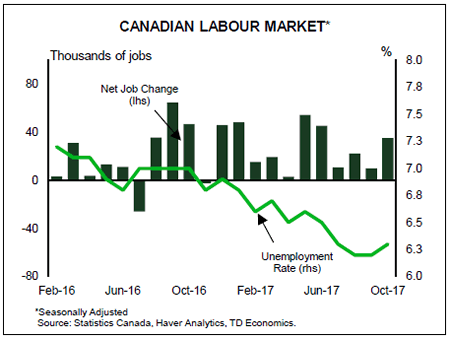U.S. Highlights
- In a Thanksgiving-shortened week, there was plenty to be thankful for as far as the U.S. economy in 2017. Growth has accelerated well above trend, and unemployment is at a 17-year low. Moreover, the economy is showing signs of rebounding from the hurricane-related devastation.
- Fed Chair Janet Yellen announced that she will resign her seat on the Board when Jerome Powell is sworn in as Chair. America can be thankful for her deft management of monetary policy over the past four years.
- Congress returns after the Thanksgiving break next week, and has three weeks to reach a compromise on tax legislation if it wants to achieve its Christmas deadline. A deal is within reach if Republicans are willing to compromise on the size of tax cuts.
Canadian Highlights
- It was generally a weak week, with wholesale and retail trade volumes both falling in September. The latest headlines from the NAFTA discussions suggest that negotiators remain far apart on a number of key issues. Concluding the talks this winter appears optimistic at best at this time.
- We expect third quarter GDP growth to be reported at 1.7% next Friday, a marked deceleration from recent quarters. Most important in the report will be the signals regarding momentum heading into the end of the year. A weak signal would likely extend the Bank of Canada’s current pause in interest rate normalization.
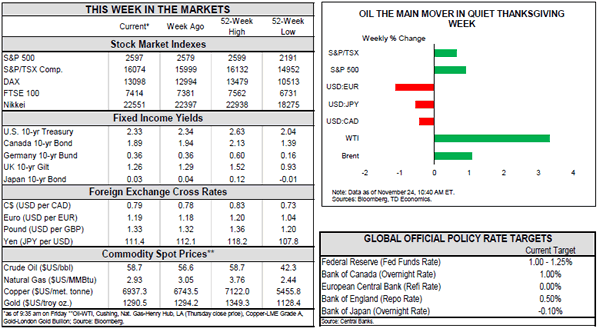
U.S. – Plenty to be Thankful For
It was a fairly quiet week for markets and economic data, given the Thanksgiving holiday. Taking a step back from the week-to-week news, there is certainly plenty to be thankful for when it comes to the economy. Growth has accelerated through 2017, and the unemployment rate has continued to fall. The unemployment rate was at a 17-year low in October, and broader measures of underemployment are now in line with pre-recessionary lows.
There are also further signs that regions devastated by the hurricanes are starting to recover. Existing home sales were up in October, as activity returned to normal particularly in hurricane affected regions (see Chart 1). Encouragingly, strong demand was also observed in other regions, as the October data marked the third consecutive increase in home sales. While some disruptions, including supply constraints, could linger a bit longer, we anticipate a gradual improvement through the end of the year, as hurricane-affected areas return to normalcy. Beyond the next few months, housing demand activity should remain buoyant alongside an improving labor market.
The minutes from the FOMC’s meeting earlier this month showed that many members see the economy as "operating at or above full employment". The Fed can also be thankful that the balance sheet normalization process has gotten underway without a hitch. In fact, members agree that the next Fed statement in December should only contain a brief reference to the program, and subsequent statements might not mention the program at all.
America can also be thankful for Fed Chair Janet Yellen’s deft management of monetary policy over the past four years. She has competently executed the gradual removal of the extraordinary stimulus put in place to deal with the financial crisis. But, change is inevitable and on Monday Chair Yellen announced her resignation from the Board once Jerome Powell is sworn in as Chair.
Sound monetary policy has helped U.S. economic activity recover over the last decade. Next week, we’ll receive the second estimate of Q3 GDP growth, which was initially reported at a solid 3% annualized rate. Recent indicators suggest we could see an upgrade to around the 3.3% mark. Right now, growth in the fourth quarter is tracking just shy of 3%. Looking at recent history, the economy seems to finally have got its groove back after a period of softness through 2015-2016 (see Chart 2).
Clearly this is not an economy in need of fiscal stimulus. Nevertheless, the Senate will return from its Thanksgiving break next week, and forge full-steam ahead to try to pass its tax cut legislation. In its current form, the proposed Senate tax cut would provide a small fiscal boost over the next few years, but also contains many unpopular elements.
Congress has three weeks to reach a compromise if they want to put a bill before the President by Christmas. It’s a tight timeline. But, if Republicans are willing to compromise, perhaps by reducing the size of the corporate tax cut in order to preserve either the Affordable Care Act’s individual mandate or other popular deductions currently on the chopping block, a deal is within reach.
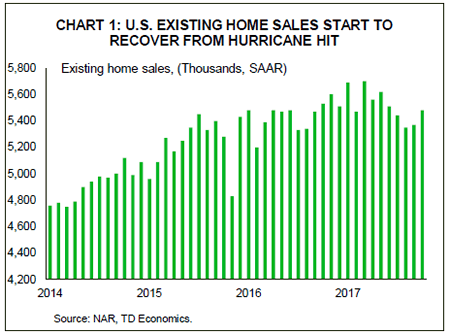
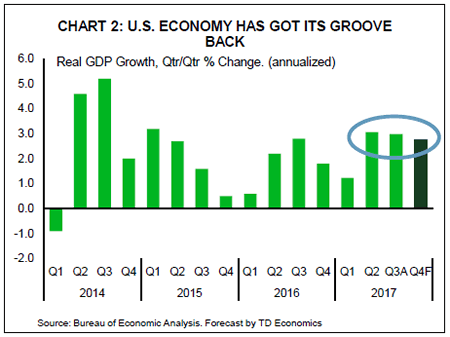
Canada – Reality Bites
This week we got another reminder that the unsustainably strong growth of the Canadian economy over the past few quarters is giving way to a more modest (but still healthy) pace of growth. One-off shocks, including hurricane impacts in the U.S. and retooling activity at major plants suggest that the deceleration in Q3 is likely to be more dramatic than anticipated. Ultimately though, the moderation should not be a surprise: with an output gap that is effectively closed, Canada is entering a mature phase of the economic cycle.
Broadly consistent with this theme, the economic data this week was something of a mixed bag. Starting with the positives, wholesale trade volumes fell back somewhat in September on relatively broad-based softness, but with healthy gains in prior months, sales volumes remained up on the quarter (Chart 1). This was the sixth straight quarterly expansion of wholesale sales volumes, marking the best run for this indicator since 2005/2006. Profits also continued to rise, with Statistics Canada reporting an 8.5% quarter-on-quarter gain in operating profits for Q3. Financial corporations led the way, helped by the Bank of Canada’s summer interest rate hikes, but profits among manufacturers and retailers were also generally up. One notable exception was motor vehicle and parts makers, where the already mentioned retooling hit activity and ate into profitability.
It was not all rosy news however. NAFTA negotiations are seeing little progress, with revised U.S. negotiating objectives released late last week suggesting little movement towards compromise on a number of contentious issues including local content requirements. At this point, it seems safe to assume that the process will not be completed by the spring 2018 target, prolonging uncertainty.
Also disappointing expectations were Canadian retail sales. While a tiny of headline gain was eked out thanks to rising gas prices, volumes fell for a third straight month (Chart 2). The retail trade data provide a view into only a slice of overall consumer spending, but suggests that unlike in recent quarters, consumption is likely to play a diminished role in overall economic growth.
Just how diminished a role will be answered next Friday, December 1st, when Statistics Canada releases its estimate of third quarter GDP. Current tracking points to growth of 1.7% quarter-on-quarter annualized, a marked deceleration from Q2’s red-hot 4.5% pace. As is typical, there are risks around this expectation: international trade in goods was very weak in the second quarter, but there is also the question of how Statistics Canada will treat the robust jobs figures, particularly hours worked.
Beyond these immediate questions lies the unknown of how the Bank of Canada will interpret the figures. A 1.7% pace of growth would be in line the with Bank’s expectations in the October Monetary Policy Report, meaning the more crucial information will relate to economic momentum heading into the final months of the year. The generally soft economic performance in September (labour markets excluded) suggests that there may be less momentum than the Bank is anticipating. When considered in the context of ‘intense data dependency’, a soft out-turn in the data may delay any Bank action.
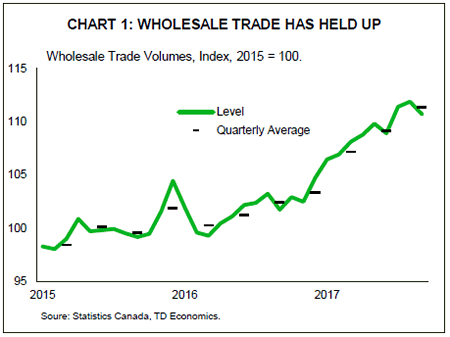
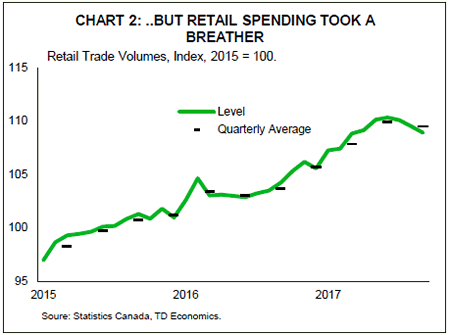
U.S.: Upcoming Key Economic Releases
U.S. Personal Income & Spending – October
Release Date: November 30, 2017
Previous Result: Income 0.4% m/m, Spending 1.0% m/m
TD Forecast: Income 0.3% m/m, Spending 0.3% m/m
Consensus: Income 0.3% m/m, Spending 0.3% m/m
Headline PCE inflation is expected to slip marginally to 1.5% in October, reflecting a 0.1% rise in prices on the month. Some giveback from gasoline prices, which surged following the hurricanes, is the main source of the deceleration. Food prices are also expected to be flat for the third month, which will keep prices little changed on a y/y basis. Excluding food and energy, core PCE inflation is likely to firm to 1.4% y/y on a 0.2% m/m increase. However, the unrounded m/m increase is likely to be weaker than that reported in the CPI release: healthcare services prices have a higher weight in PCE and we expect them to remain weak in the October PCE report.
Nominal PCE (personal spending) is expected to rise 0.3% in October. This indicates a solid footing for real spending, which is tracking well above a 2% pace for Q4. We expect gains to be driven by nondurables and services, with a modest drag from vehicle sales as they come off their hurricane-induced September highs. We also expect a firmer 0.4% increase in October personal income, leading the personal savings rate marginally higher.
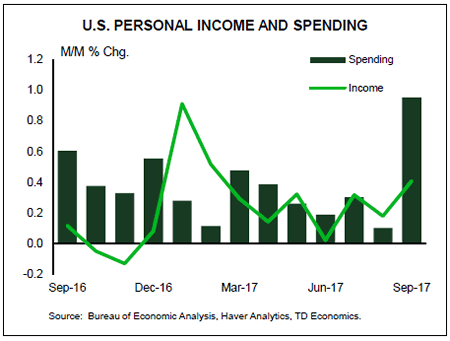
U.S. ISM Manufacturing Index – November
Release Date: December 1, 2017
Previous Result: 58.7
TD Forecast: 57.9
Consensus: 58.3
We expect the ISM manufacturing PMI to slip further to 57.9, reflecting some give back from prior hurricane-induced strength. The supplier deliveries component, which surged after the hurricanes, should drive the moderation as it still remains several points above its recent trend. Employment growth could also come off relatively toppish levels. Scope for a significant drop in the overall index is low given the continued strength in regionals surveys, and as such we expect the ISM PMI to stand near its 6-month average in the 57-58 range. Such levels are consistent with healthy above-trend GDP growth near 3% for the fourth quarter.
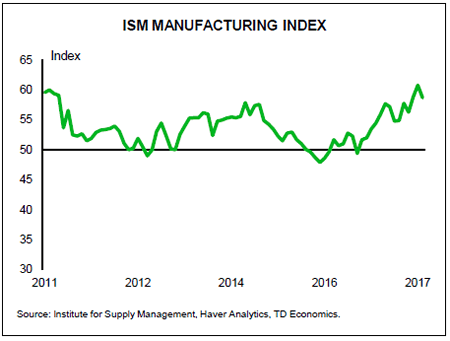
Canada: Upcoming Key Economic Releases
Canadian Real GDP – Q3 and September
Release Date: December 1, 2017
Previous Result: 4.5% q/q (annualized), -0.1% m/m
TD Forecast: 1.7% q/q (annualized), 0.1% m/m
Consensus: N/A
Canadian economic growth is expected to have come back down to earth with a 1.7% (q/q, annualized) expansion in the third quarter. The key culprit behind the deceleration looks to be net trade, as goods export volumes fell 14% on the quarter, far outpacing a modest pullback in imports. Consumer expenditures are expected to decelerate somewhat, to 2.7%. Much of the resilience in spending is pinned on services – an area with limited early indicators, thus presenting a slight downside risk to growth expectations. The volatility in housing markets in the wake of Ontario’s Fair Housing Plan will likely be manifested in a second quarterly contraction (-5.5%). Offsetting this weakness somewhat is an expected uptick in business inventories, and still healthy non-residential investment (+5.8%) as firms continue their gradual reinvestment process.
Industry-level GDP should post a 0.1% increase in September owing to a rebound in the goods producing sector. Manufacturing output will benefit from a sharp increase in gasoline production though we see two way risks to output further upstream. We also look for a pickup in construction and utilities output, with the latter driven by a late summer heat wave. Things look less upbeat on the services side, with retail and wholesale trade significantly weaker on the month, though stronger housing activity should help to support the headline print.
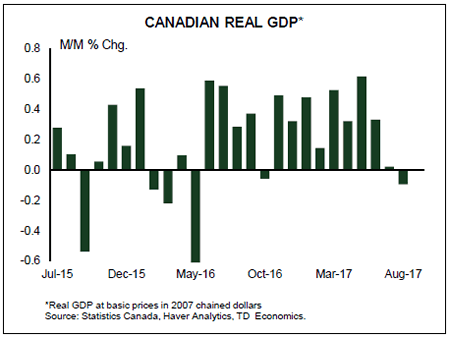
Canadian Employment – November
Release Date: December 1, 2017
Previous Result: 35.3k, unemployment rate: 6.3%
TD Forecast: 15k, unemployment rate: 6.3%
Consensus: N/A
We look for the labour market to remain on a solid footing in November with the addition of 15k jobs, which should leave the unemployment rate at 6.3%. We expect the details of the report to show an outperformance in the service sector and part-time employment is also likely to rebound after the loss of 150k positions over the last two months. Average hourly earnings have risen by an average of 0.4% m/m since June and we are likely to see a more moderate increase in November; however wage growth is still likely to push to 2.5% y/y or higher on account of modest base effects. Lastly, rising labour force participation for young workers should help keep the unemployment rate stable at 6.3% with risks leaning higher. College students have been out of school since October 16th due to faculty strikes and we look for more students to seek part time work as the disruptions drag on longer.
Chart: Canadian Employment
